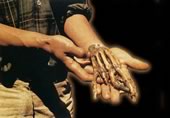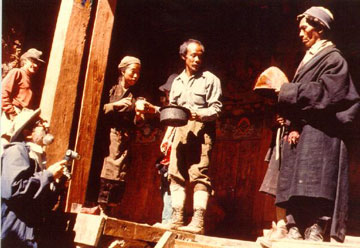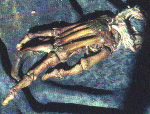
July 21, 2011

Jon Carroll of the San Francisco Chronicle in a May 29, 2007 article, wrote a column in which, in passing, he mentioned that the Pangboche Hand was viewed but that it did not impress the journalist.
Of course, this Nepalese ritualized object should not have looked too authentic. It is only a shadow of its former self.
The Pangboche Hand, the so-called Yeti Hand, has been the point of much discussion for almost 50 years in the West, which I summarized in Tom Slick: True Life Encounters in Cryptozoology (Fresno, CA: Craven Street-Linden Press, 2002).
The Abominable Snowman Hand lives on, as well, besides in Nepal, now in Florida, of course. You can see for yourself this summer, if you wish.
As you enter the museum-like area before the ride at the relatively recent Yeti attraction at the Disney World-Orlando’s Expedition Everest, you are greeted with all kinds of real or nearly authentic paintings (such as the following) from Nepal and Tibet of the Abominable Snowmen of the Himalayas. You are also made aware of the rich history of the encounters with Yeti through photographs.
Disney planners used one of my photographs of the Tom Slick Yeti cast found in my collection, and asked me to consult with them about others they might wish to obtain.
One object of interest, of course, was the Pangboche Hand. The fact is the hand at Pangboche is not the original hand seen by the Tom Slick expedition in the late 1950s. The bones of that hand were taken in 1959, and replaced with human bones. When Sir Edmund Hillary debunked the Pangboche Hand in 1960, he had ever reason to do so. That hand, at least in the central portion, was mostly a reconstructed human hand. All who have seen the hand since 1960 have viewed and photographed a fake.

During the planning stages of the creation of the Disney World attraction Expedition Everest, the designers ask me for a recommendation on someone who would sell them photographs of the current Pangboche hand. I referred them to Marc Miller (pictured on the left in the photograph below). A few years ago, Miller related, to his local newspaper, his personal search for Yeti and the link to the Disney display.

Cryptozoologist Marc E.W. Miller and four of his colleagues left Ohio for Nepal and the Tibet border in February 1986 to search for evidence of a Yeti – commonly known as the Abominable Snowman or Bigfoot. When Miller, a Lancaster native, left for his great adventure 22 years ago, he never imagined he would hold what was believed to be the scalp of a Yeti, receive possible hair samples from a Yeti and take a picture with what is believed to be a Yeti’s hand.

“To find something is unexplainable,” Miller said. “It’s how you feel when you win. … It’s that adventure and excitement.”
A cryptozoologist is a researcher who studies creatures that haven’t been proved to exist.
The picture of Miller holding a case with the Yeti’s hand is now displayed for people from all over the world to see while enjoying the thrills of “Expedition Everest” at Walt Disney World’s Animal Kingdom.

The Everest Expedtion rollercoaster train stops in the museum briefly during the ride. The ride opened two months ago in the Buena Vista, Fla., Disney theme park and features an exciting real-life depiction of what the Himalayan mountains are like – including a life-like encounter with the Yeti. But finding possible evidence of the Yeti is the outcome of only one of Miller’s world expeditions.
Miller, who has practiced as a neuropsychologist in Lancaster for more than 25 years, has been all over the world. He has explored primitive society in Africa, searched for rare animals in China and Egypt, withstood various types of climates and dangerous situations and wrote two books about his adventures. One of his most prized finds was a rare species of the Asian elephant in China.
“I was paralyzed when I saw it,” he said.
Pictures and keepsakes of all of his adventures hang on the walls of his safari-themed neuropsychology office. Having an artifact from one of his expeditions displayed publicly is something Miller thinks is quite unique. He plans to go to Florida to see the Yeti attraction one day.
“I’m happy I’ve lived and got to see more primitive society,” Miller said. “I’ve had quite a few adventures.”
About Loren Coleman
Loren Coleman is one of the world’s leading cryptozoologists, some say “the” leading living cryptozoologist. Certainly, he is acknowledged as the current living American researcher and writer who has most popularized cryptozoology in the late 20th and early 21st centuries.
Starting his fieldwork and investigations in 1960, after traveling and trekking extensively in pursuit of cryptozoological mysteries, Coleman began writing to share his experiences in 1969. An honorary member of Ivan T. Sanderson’s Society for the Investigation of the Unexplained in the 1970s, Coleman has been bestowed with similar honorary memberships of the North Idaho College Cryptozoology Club in 1983, and in subsequent years, that of the British Columbia Scientific Cryptozoology Club, CryptoSafari International, and other international organizations. He was also a Life Member and Benefactor of the International Society of Cryptozoology (now-defunct).
Loren Coleman’s daily blog, as a member of the Cryptomundo Team, served as an ongoing avenue of communication for the ever-growing body of cryptozoo news from 2005 through 2013. He returned as an infrequent contributor beginning Halloween week of 2015.
Coleman is the founder in 2003, and current director of the International Cryptozoology Museum in Portland, Maine.
Filed under Abominable Snowman, Artifacts, Breaking News, Cryptotourism, CryptoZoo News, Cryptozoologists, Cryptozoology, Evidence, Expedition Reports, Forensic Science, Media Appearances, Museums, Photos, Pop Culture, Tom Slick, Yeti